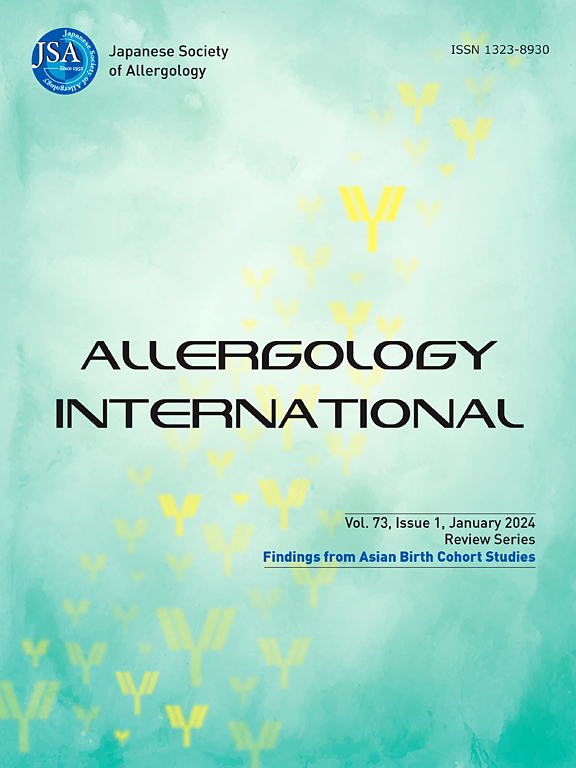Neutrophils predominate as IL1B-expressing cells in Schnitzler syndrome: Insights from the SCan study to evaluate the efficacy and safety of canakinumab in Japanese patients
IF 6.7
2区 医学
Q1 ALLERGY
引用次数: 0
Abstract
Background
Schnitzler syndrome (SchS) is a late-onset autoinflammatory disease characterized by urticarial rash and monoclonal gammopathy. SchS shares clinical features with cryopyrin-associated periodic syndrome, which is driven by gain-of-function mutations in NLRP3, and while IL-1β-targeted therapies have shown efficacy, the underlying pathogenesis of SchS remains unclear.
Methods
During a multicenter, single-arm, open-label, investigator-initiated trial evaluating the efficacy and safety of canakinumab in five Japanese patients with SchS (named the SCan Study after SchS and Canakinumab), based on a similar study conducted in Germany, we measured 32 cytokines/chemokines and 11 complement-related factors in plasma and analyzed their correlations with changes in clinical symptoms during treatment. Furthermore, in two cases, single-cell RNA sequencing of peripheral blood and spatial transcriptomic analysis of lesional skin were performed to identify IL1B-expressing cells.
Results
The improvement in clinical symptoms and quality of life was maintained for 48 weeks following canakinumab treatment. Notably, these changes in clinical symptoms strongly correlated with WBC count, neutrophil count, CRP, and serum amyloid A levels, which were used as evaluation parameters in this study. In contrast, IL-1β and most other cytokines/chemokines exhibited distinct patterns and were not useful as markers of disease activity. IgM levels remained stable without an upward trend. Additionally, IL1B-expressing cells were predominantly neutrophils in both peripheral blood and lesional skin. Furthermore, neutrophil counts in peripheral blood decreased following canakinumab administration.
Conclusions
This study demonstrated that the primary source of IL1B-expressing cells in SchS is neutrophils. Moreover, canakinumab improves clinical symptoms by regulating neutrophil dynamics in peripheral blood.
中性粒细胞作为表达il1b的细胞在Schnitzler综合征中占主导地位:来自SCan研究的见解,以评估canakinumab在日本患者中的有效性和安全性。
背景:Schnitzler综合征(SchS)是一种以荨麻疹和单克隆γ病为特征的迟发性自身炎症性疾病。SchS与cryopyrin相关周期性综合征具有相同的临床特征,后者是由NLRP3的功能获得性突变驱动的,尽管il -1β靶向治疗已显示出疗效,但SchS的潜在发病机制尚不清楚。方法:在一项多中心、单组、开放标签、研究者发起的试验中,评估了canakinumab对5名日本SchS患者的疗效和安全性(以SchS和canakinumab命名的SCan研究),基于德国的一项类似研究,我们测量了血浆中的32种细胞因子/趋化因子和11种补体相关因子,并分析了它们与治疗期间临床症状变化的相关性。此外,在两个病例中,通过外周血单细胞RNA测序和病变皮肤的空间转录组分析来鉴定表达il1b的细胞。结果:canakinumab治疗后临床症状和生活质量的改善维持了48周。值得注意的是,这些临床症状的变化与WBC计数、中性粒细胞计数、CRP和血清淀粉样蛋白A水平密切相关,这些是本研究的评估参数。相比之下,IL-1β和大多数其他细胞因子/趋化因子表现出不同的模式,不能作为疾病活动的标志物。IgM水平保持稳定,没有上升趋势。此外,外周血和病变皮肤中表达il1b的细胞主要是中性粒细胞。此外,canakinumab给药后,外周血中性粒细胞计数下降。结论:本研究表明,SchS中il1b表达细胞的主要来源是中性粒细胞。此外,canakinumab通过调节外周血中性粒细胞动力学改善临床症状。
本文章由计算机程序翻译,如有差异,请以英文原文为准。
求助全文
约1分钟内获得全文
求助全文
来源期刊

Allergology International
ALLERGY-IMMUNOLOGY
CiteScore
12.60
自引率
5.90%
发文量
96
审稿时长
29 weeks
期刊介绍:
Allergology International is the official journal of the Japanese Society of Allergology and publishes original papers dealing with the etiology, diagnosis and treatment of allergic and related diseases. Papers may include the study of methods of controlling allergic reactions, human and animal models of hypersensitivity and other aspects of basic and applied clinical allergy in its broadest sense.
The Journal aims to encourage the international exchange of results and encourages authors from all countries to submit papers in the following three categories: Original Articles, Review Articles, and Letters to the Editor.
 求助内容:
求助内容: 应助结果提醒方式:
应助结果提醒方式:


